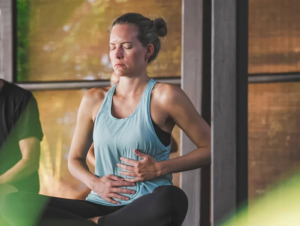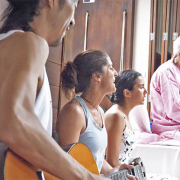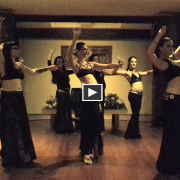 https://samahitaretreat.com/wp-content/uploads/2019/11/Beach-Fire-with-Daphne-Tse-and-Matthew-Cohen.jpg
491
1000
Daniel Stringer
http://samahitaretreat.com/wp-content/uploads/2024/01/samahita-logo-v2.svg
Daniel Stringer2019-11-26 00:00:002024-02-15 09:32:52Beach Fire with Daphne Tse and Matthew Cohen
https://samahitaretreat.com/wp-content/uploads/2019/11/Beach-Fire-with-Daphne-Tse-and-Matthew-Cohen.jpg
491
1000
Daniel Stringer
http://samahitaretreat.com/wp-content/uploads/2024/01/samahita-logo-v2.svg
Daniel Stringer2019-11-26 00:00:002024-02-15 09:32:52Beach Fire with Daphne Tse and Matthew CohenNavigate the World of Breathing
Breathwork, breathing exercises, prānāyāma, whatever it is, the first step is to get clear on how to breathe. Meaning, as nature intended this human body to breathe efficiently and work well.
Diaphragm- Deep- Belly- Breaths. Which is it? Is “diaphragmatic breathing” a reasonable term for proper breathing? And if you don’t really know for sure where the diaphragm is in the body and what it attaches to how do you know if you are even doing a “diaphragmatic breath”?
First, all inhalations use the diaphragm, by default. Their motor innervation (i.e. nerves to make it do some action) are the phrenic nerves. When the brain’s respiratory processing center sends an impulse to breathe it follows that the motor unit for the diaphragm receives the command.
Second, the issue then is not if the diaphragm is being used or not BUT rather is the diaphragm being properly and effectively used?
Third, the diaphragm is a muscle, one of the most powerful in your body. Yet many people have a poorly developed diaphragm, which translates to less than adequate inhales that rely more on chest activity.
Fourth, seeing more movement in the chest, especially at the beginning of the inhale, leads one to say “you are breathing poorly and not using your diaphragm.” Though technically a little incorrect the message is good.
Fifth, so how can you identify then if it is a good “diaphragmatic breath”? You will see movement in the soft tissue of the upper abdomen followed by the side ribs. This follows, almost traces, the line of attachment of the diaphragm to the costal arch (front rib cage), where the pressure extends into the soft tissue of the upper abdomen.
Hopefully that is clear. A question that often follows such a description is if this is also a “belly breath” and would it still be if the expansion happened below the navel? Essentially, is a “belly breath” the same as a “diaphragmatic breath”?
First thing to note here, however, is that a “belly breath” is quite often a poor quality breath if done with force or depth, inefficient as the whole abdomen is collapsed and moves – hence “Belly”. A big inhale with emphasis on a rounded (and dropped) abdomen limits the diaphragm and how the ribs get involved in the act of breathing.
Yet when sitting in a very quiet position, usually when concentrating on a topic (like reading this:) or in a meditative sitting practice, then the only movement is “belly”, meaning around the navel. Ironically, this “belly breath” is passive, light, soft where the only observable movement is the “belly” at the navel. Interestingly it occurs so nicely because the diaphragm, being well-trained, is working so well.
So the passive, soft “belly” breath movement is really a minimal but well-trained diaphragmatic breath.
When you do a partial to fully active “diaphragmatic breath” then the control in the “belly” changes – supported below navel and moving above navel. That is a well-trained “active diaphragmatic breath” that could be termed “managed belly breathing”.
No doubt you have been told, and perhaps have even given the advice, to “take a deep breath”. But what does it mean? Under which conditions does taking a big deep inhale even work? Ironically most people say it to others when stressed out or anxious. Yet emphasis on the inhale in such sitations is not so helpful.
Typically if I am in a situation where someone really needs some breath advice, as opposed to vernacular use of “take a breath” (aka chill TF out), then I guide them to slowly and deliberately exhale. A good exhale means an improved inhale will follow.
In this case “DEEP” refers to the descent of the diaphragm which allows for best expansion of the lung tissue and suction of oxygen carrying air in to “deeper” recesses of the lungs thereby covering greater surface area of lung volume, reaching more alveoli (air sacs in the lungs).
To be able to take this “deep breath” requires good use of your diaphragm, so a good active “diaphragmatic breath”, whereby the soft tissue of the upper abdomen moves or expands slightly, followed by lateral horizontal movement (i.e. sideways) of the lower ribs. Below the navel stays supported.
This is a deep well-managed belly breath, really a “diaphragmatic breath”, which is a deep breath due to its effect in the lungs: DEEP. This capacity reflects itself in quiet passive breathing with minimal movement at the navel, but its effect is free “to drop” and in this case becomes passively “DEEP”.
Having learned how to breathe it is fair to ask, what is breathwork? It has become a popular word lately. It can refer to a plethora of breathing exercises. However, I would emphasize breathwork more so under a type of breath training. And this training leads to an improved diaphragm and well-defined act of breathing.
The outcome of this means your breathing, the function of respiration, works well at times beyond the training period. Meaning when you are engaged in a variety of other tasks which includes sleeping.
If you’re still reading, potentially interested, then a second question is what is prānāyāma? Prānāyāma is skillful use of the breath with controlled inhalation and exhalation, and most typically involves controlled retention of the breath.
Is prānāyāma a breathwork practice? The skill developed in using the breath in breathwork training is needed to further control the breath when sitting to do prānāyāma. So it could be said breathwork is a prerequisite for adequate prānāyāma to be undertaken.
Breathwork, especially in the popular sense, primarily focuses on breathing. Prānāyāma incorporates breathing with bodily support to control the breath and retain it with ideally a directed focus inward to where the control in the body over the breath is managed.
How to start or improve on some breathwork you may already have begun? Begin with the simplest of breathwork techniques: sit, start an exhale, pause, take an inhale through your nose, pause, again exhale, ideally longer than the inhale, pause, inhale through your nose, pause, and continue.
“Too basic” you say. Good. But do you sit and do this (or more) daily? If not then this is far from too basic. It is foundational. The key is to do regularly, even if very basic.
You can develop more within breathwork and on into prānāyāma. This knowledge and skill of breath we have been sharing at Samahita since we opened almost 21 years ago.
Come, learn, stabilize it, take it home, keep it up.

Paul Dallaghan’s expertise with breathwork, body and meditative practices comes from three sources: over 25 years of daily dedicated practice and teaching these techniques; immersion in the original culture through one-on-one direct training in practice and study of ancient texts; doctoral scientific research at a leading US university (Emory) on yoga and breath in terms of stress, health and aging. Paul occupies a unique space to impart genuine teaching and science on these practices, acknowledged by his teacher and lineage (Kuvalayananda) in India as a Teacher-of-teachers and a Master of Breath, identified to carry the tradition (Pranayama). This places him as the only master-level yoga and breath practitioner currently immersed in scientific academic research on breathwork, stress and health. His sincere and ongoing role is to teach, write and research to help put out experienced and authentic information on these areas in a world full of confusion and conflicting messages both off and online.
For more on his background see his bio.
More from the Samahita Blog



